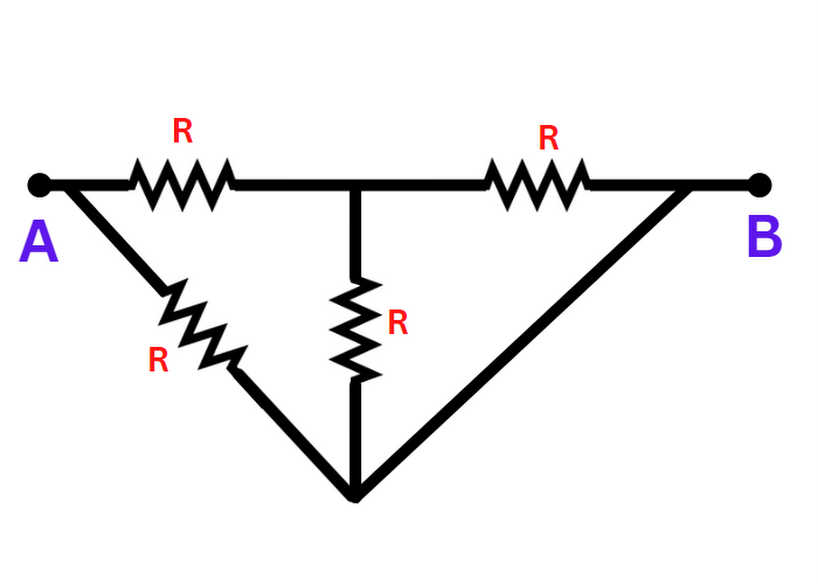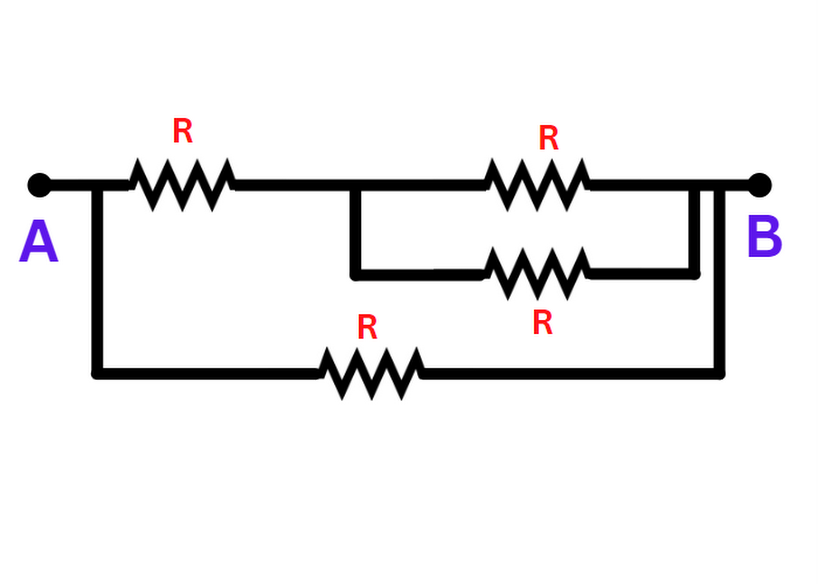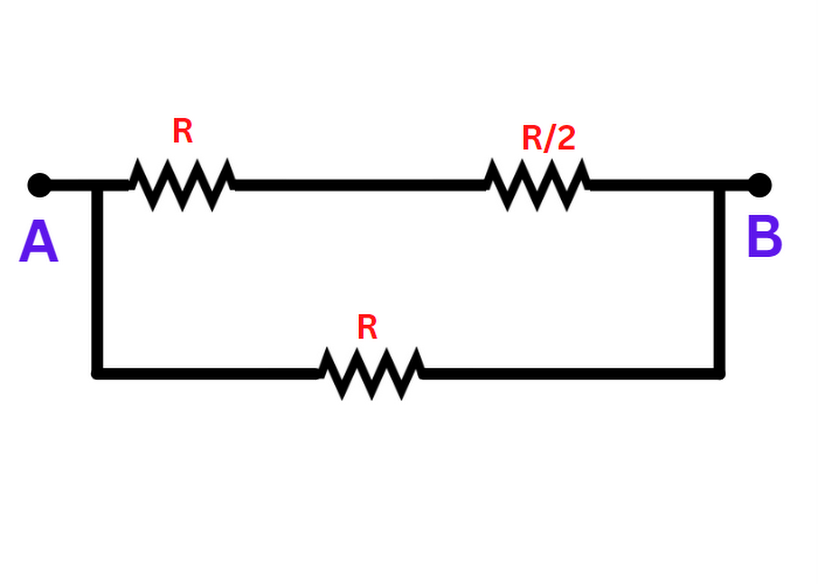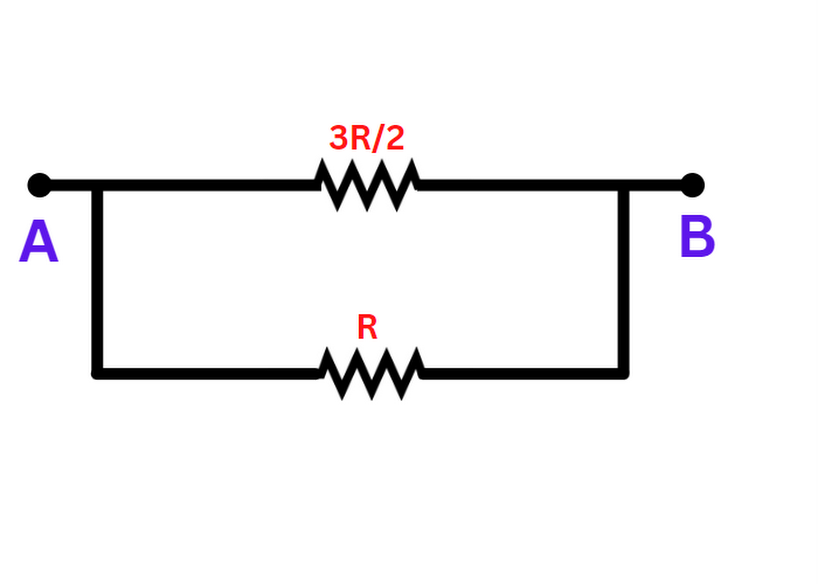
The equivalent resistance between points A and B is

A) 2R
B) (3/4) R
C) (4/3) R
D) (3/5) R
Answer
216.3k+ views
Hint:The problem is from the electricity part of physics. We can apply the concept of parallel combination and series combination of resistance here. Use the equation for effective resistance in parallel and series combinations.
Formula Used:
Equivalent resistance for a series resistance circuit:
${R_E} = {R_1} + {R_2} + {R_3}$
Where ${R_E}$= equivalent resistance and ${R_1},{R_2},{R_3}$ = component resistance.
Equivalent resistance for a parallel resistance circuit:
$\dfrac{1}{{{R_E}}} = \dfrac{1}{{{R_1}}} + \dfrac{1}{{{R_2}}} + \dfrac{1}{{{R_3}}}$
Where ${R_E}$= equivalent resistance and ${R_1},{R_2},{R_3}$ = component resistance.
Complete answer:
The equivalent resistance is a single resistance which can replace all the component resistances in a circuit in such a manner that the current in the circuit remains unchanged.
Let’s redraw the circuit diagram for simplicity.

Figure 1
The equivalent resistance for the parallel resistance connection is
$\dfrac{1}{{{R_E}}} = \dfrac{1}{R} + \dfrac{1}{R} = \dfrac{2}{R} \Rightarrow {R_E} = \dfrac{R}{2}$
The circuit diagram will be

Figure 2
The equivalent resistance for the series resistance connection is
${R_E} = \dfrac{R}{2} + R = \dfrac{3}{2}R$
Now the circuit diagram will be

Figure 3
Now the equivalent resistance for the final parallel resistance connection is
${R_{AB}} = \dfrac{{\dfrac{3}{2}R \times R}}{{\dfrac{3}{2}R + R}}$
${R_{AB}} = \dfrac{3}{2}{R^2} \times \dfrac{2}{{5R}} = \dfrac{3}{5}R$
Hence, the correct option is Option (D).
Note: Resistance is a measure of the opposition to current flow in an electrical circuit. Resistance blocks the flow of current. The current decreases as resistance increases. On the other hand, the current increases as the resistance decreases. In short circuit conditions the current through the circuit increases exponentially because resistance of the circuit becomes zero.
Formula Used:
Equivalent resistance for a series resistance circuit:
${R_E} = {R_1} + {R_2} + {R_3}$
Where ${R_E}$= equivalent resistance and ${R_1},{R_2},{R_3}$ = component resistance.
Equivalent resistance for a parallel resistance circuit:
$\dfrac{1}{{{R_E}}} = \dfrac{1}{{{R_1}}} + \dfrac{1}{{{R_2}}} + \dfrac{1}{{{R_3}}}$
Where ${R_E}$= equivalent resistance and ${R_1},{R_2},{R_3}$ = component resistance.
Complete answer:
The equivalent resistance is a single resistance which can replace all the component resistances in a circuit in such a manner that the current in the circuit remains unchanged.
Let’s redraw the circuit diagram for simplicity.

Figure 1
The equivalent resistance for the parallel resistance connection is
$\dfrac{1}{{{R_E}}} = \dfrac{1}{R} + \dfrac{1}{R} = \dfrac{2}{R} \Rightarrow {R_E} = \dfrac{R}{2}$
The circuit diagram will be

Figure 2
The equivalent resistance for the series resistance connection is
${R_E} = \dfrac{R}{2} + R = \dfrac{3}{2}R$
Now the circuit diagram will be

Figure 3
Now the equivalent resistance for the final parallel resistance connection is
${R_{AB}} = \dfrac{{\dfrac{3}{2}R \times R}}{{\dfrac{3}{2}R + R}}$
${R_{AB}} = \dfrac{3}{2}{R^2} \times \dfrac{2}{{5R}} = \dfrac{3}{5}R$
Hence, the correct option is Option (D).
Note: Resistance is a measure of the opposition to current flow in an electrical circuit. Resistance blocks the flow of current. The current decreases as resistance increases. On the other hand, the current increases as the resistance decreases. In short circuit conditions the current through the circuit increases exponentially because resistance of the circuit becomes zero.
Recently Updated Pages
Wheatstone Bridge Explained: Working, Formula & Uses

Young’s Double Slit Experiment Derivation Explained

JEE Atomic Structure and Chemical Bonding important Concepts and Tips

JEE Amino Acids and Peptides Important Concepts and Tips for Exam Preparation

Electricity and Magnetism Explained: Key Concepts & Applications

Chemical Properties of Hydrogen - Important Concepts for JEE Exam Preparation

Trending doubts
JEE Main 2026: Application Form Open, Exam Dates, Syllabus, Eligibility & Question Papers

Derivation of Equation of Trajectory Explained for Students

Hybridisation in Chemistry – Concept, Types & Applications

Understanding the Angle of Deviation in a Prism

Understanding Collisions: Types and Examples for Students

How to Convert a Galvanometer into an Ammeter or Voltmeter

Other Pages
JEE Advanced Marks vs Ranks 2025: Understanding Category-wise Qualifying Marks and Previous Year Cut-offs

Understanding Atomic Structure for Beginners

Ideal and Non-Ideal Solutions Explained for Class 12 Chemistry

Degree of Dissociation: Meaning, Formula, Calculation & Uses

Understanding Electromagnetic Waves and Their Importance

Understanding the Electric Field of a Uniformly Charged Ring




